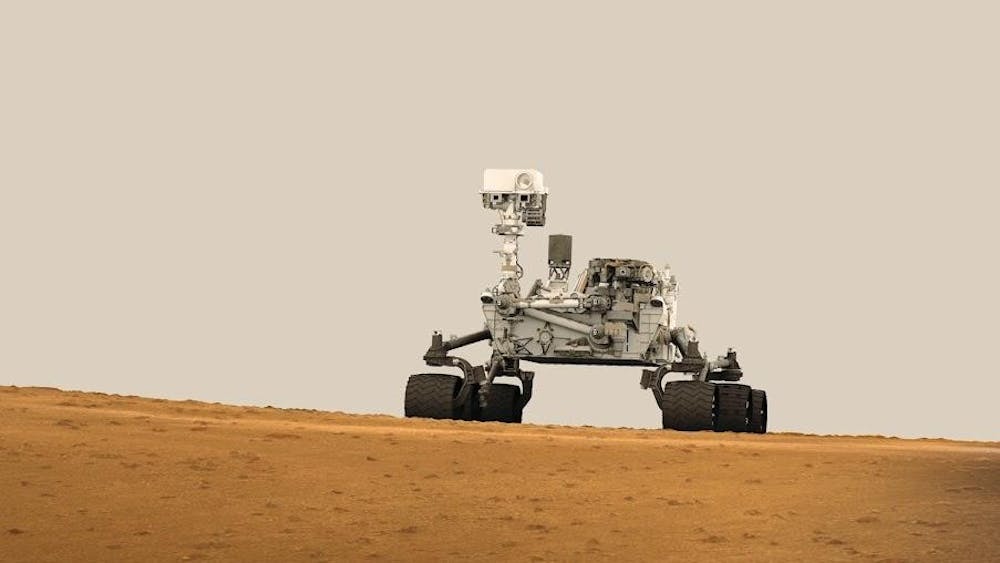By Alex Mellen
Even a robot on a mission can stop and have some fun once in awhile. Curiosity, the Mars rover that arrived on the Red Planet Aug. 5, broadcast rapper will.i.am's specially-written pop anthem, "Reach for the Stars," from the surface of Mars Aug. 28, Reuters reported.
It's a study break for the rover on its two-year mission to examine the geological and chemical makeup of the Red Planet.
After a long flight and a dramatic landing, Curiosity stretched its wheels, peered inside a rock and gave Mars its first shout-out from Earth. And the journey NASA scientists have been planning for almost a decade is just beginning.
After rotating its wheels Aug. 21, Curiosity did a short Martian shuffle the next day, wheeling forward, turning 120 degrees and wheeling backward, according to The Guardian. It still resides at Bradbury Landing, named for science fiction author Ray Bradbury, The New York Times said, but the test was crucial.
"It couldn't be more important," Peter C. Theisinger, mission project manager, told The New York Times. "I mean, we built a rover. So unless the rover roves, we really haven't accomplished anything."
Curiosity will spend the next two years driving through a crater and climbing Mount Sharp, a 3.4-mile-high mountain inside the crater, The New York Times reported. Its primary mission is to search for evidence that Mars could have supported microbial life.
"Curiosity can't tell the type of life - just gasses and chemicals," said Taylor physics professor Hank Voss about the rover's sensors and instruments.
Instead, it's equipped to detect hydrogen, an indicator of water.
Voss explained the value of a search for water on Mars. He and many scientists believe water existed on Mars in the past and possibly exists there today.
If so, microbial life, such as Earth extremophiles that can survive the vacuum of space, could survive on Mars.
Among other tools that aid its search, Curiosity is equipped with a laser that ionizes rocks to determine their interior makeup.
According to CNN, Curiosity shot a rock nicknamed "Coronation" 30 times in a 10-second period with the high-intensity laser.
The laser's analyzer, called the ChemCam, then studied the resulting gases from 10 feet away.
Curiosity's tools are good for more than geology experiments. The New Scientist reported one device that uses X-rays to determine the composition of an object is being repurposed to help archaeologists examine artifacts without damaging them.
One of Curiosity's instruments has added to Mars instead of taking from it. The Washington Post reported the first voice on Mars belonged to NASA Administrator Charles Bolden.
Curiosity broadcast his recorded message Sept. 27, which included Bolden congratulating his team and lauding Curiosity's achievements.
These achievements could even include providing clues about life on Earth.
Voss noted that any results gathered by Curiosity, or future rovers might point to either creation or evolution as the catalyst for life.
Excitement is growing as Curiosity lives up to its namesake.
Voss, who decided to study physics after seeing men land on the moon, said Curiosity will produce a similar spike in the "inspirational atmosphere" he felt after the moon landing.
Astronaut Buzz Aldrin noted in USA Today that he expects a manned mission to Mars in the near future.
According to Voss, any water, ice or hydrogen found on Mars could be useful resources for astronauts on future missions.
Voss added that Curiosity's success will inspire scientists everywhere to be bold in trying new things.
"You need to get people to look beyond what is normally done," Voss said. "Everybody likes to do things the same way, but when you demonstrate technology on another planet with this much sophistication, it lifts the spirits."





